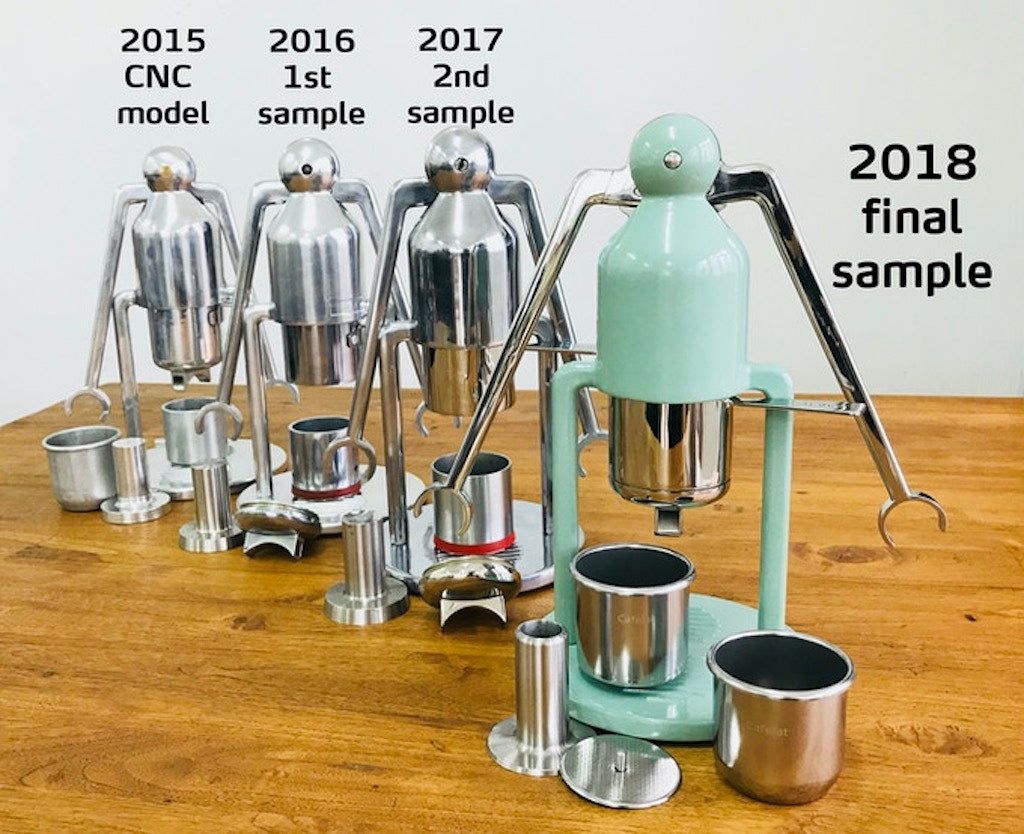History and useful links
June 3, 2021 – Kristal Yam

History of Cafelat Robot
Back in late 2013, Paul Pratt decided to update the manual espresso maker when there were only few products in the market. The overall concept is not new, but with a really fantastic design. He has a clear idea that the Robot is very simple, no heaters, no plastic and no electronics. The Presso is a modern version of a 50's idea, there were many machines like that. Cafelat Robot is more like the original 50's machines, but with upgraded materials, a bottomless and double spouted.
However, it has been a long journey to produce the specific basket when no manufacturers willing to make it properly. We spent almost 2 years to keep updating the design and convinced the manufacturer.
When everything is almost ready, we decided to use Kickstarter to first launch Cafelat Robot. We have been around for many years and our products are found all over the world, but we are a very small company. We like to take a very hands on approach to everything and are therefore involved in every step. Every product we ship out has been fabricated, assembled, and packed by us.
When we set out to make the Robot, we wanted it done properly. We could have gone small, CNC cut all the parts and that would have lowered our financial outlay since we could have produced in small quantities. But we would rather invest in the correct tooling, have it die-cast so we can meet prospective orders and aim for the machines to be making coffee decades later.
Development and Prototypes
We had the first development meeting with our friends, who manufacture cookwares, in late 2014. They came up with a few ideas a month later.

Photo: 1st draft of the coffee maker project, Jan 2015
It looked fantastic but it needed some non-slip grips. We thought about silicone overmolds, or even bakelite grips but it really ruined the simple looks. We always joked that it resembled a robot, so hey presto claws were added to make it easier to grip and press down and the Robot was born.

Photo: The Robot was born, July 2015 - note the company name! :)
Towards the end of 2015 our manufacturers very wisely decided to produce a CNC prototype of the Robot to test that our design was working. I am 101% glad we did as it gave us vital information and we learned a lot from it. We still had basket issues, so we had to have the prototype basket CNC machines as well.
The prototype allowed me to make changes to the piston shape and size, and adjust the travel of the piston to ensure we got a good drink volume.
In the end of 2016 we received the actual basket samples from our own toolings, this was the key to the whole project.

Photo: Our 2 types of filter baskets, old-style filter screen and right, a standard coffee basket

Even now, we keep improving the Robot:
- Redesigned the Robot arms by hiding the line from the top (October 2021)
- Resigned the filter screen by using the silicone top pin. Reducing the damage on misused. (October 2020)
- Installed a POM guide ring on the top of the piston. A bit of grease (Loctite Superlube) has been applied on the piston and inside the main body. (September 2020)
- 1 pack of filter paper includes in each Robot package. (June 2020)
- Metal sleeve on the Barista Robot. (January 2020)
- 1 pack of MOLYKOTE® Dow Corning 111 Silicone Compound 6g includes in each Robot package. (June 2019)
Useful links for joining community and discuss with other users
Blogs: Regularly updated on Cafelat (mostly about Cafelat Robot)
Home Barista: One of the biggest coffee forums in the world.
Facebook - Cafelat Robot Owners: Unofficial group to help owners (and wannabes) get the most from their robot.
Coffeetime UK: A friendly non profit coffee forum in the UK
Coffee Forums UK: Coffee Forums UK - the UK's premier coffee forums.

